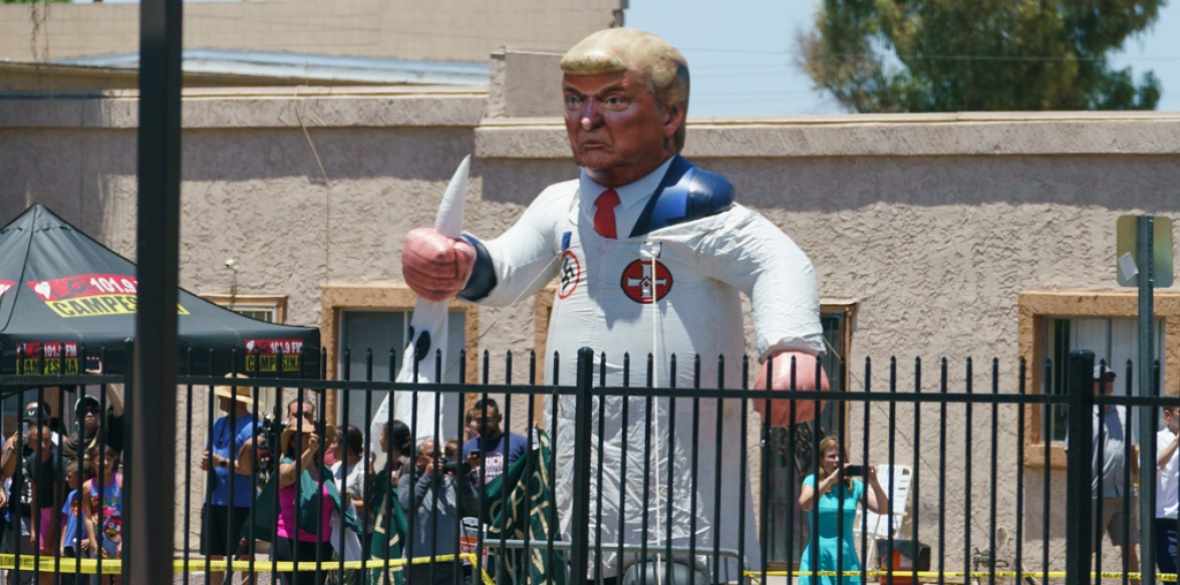This is the last article you can read this month
You can read more article this month
You can read more articles this month
Sorry your limit is up for this month
Reset on:
Please help support the Morning Star by subscribing here
THE decision by London Mayor Sadiq Khan to agree that a giant effigy of Donald Trump as a baby complete with nappy can be floated above central London when the “orange moron” — as he has been labelled — visits Britain has mostly been applauded.
One critic was, of course, Nigel Farage who continued his own tradition of being entirely ignorant about more or less everything by failing to spot that the parading (and sometimes burning) of effigies of unpopular figures is in fact a great British tradition.
Farage claimed that the crowd-funded balloon was the “biggest insult” to a US president ever.
If so, the US president must be getting used to insults since effigies of him have been paraded in Panama City, Manila and Montreal recently.
Indeed, it would seem Trump effigies are something of an international phenomenon.
The most frequent day for the parading of effigies in Britain in Victorian times (as now) was November 5 but in the 19th century effigies were much more varied than Guy Fawkes.
The tradition of effigies and sometimes the burning of them fed into the wider area of charivari, a broader form of protest, involving discordant music and general uproar.
Some of that is also expected when Trump arrives in London
According to the social historian Robert Storch, in reaction to the 1872 Licensing Act, it was almost decided in Exeter to burn an effigy of the home secretary but instead there was a chorus of groans.
From the 1870s, Storch notes, shopworkers burnt effigies of employers who refused to join in with early closing times.
Meanwhile in Bridgwater the effigy of a foreman called “Old Boss” was hung from a gallows while a crowd smashed his windows and demolished his walls.
Robert Noonan, who as Robert Tressell wrote the labour movement classic The Ragged Trousered Philanthropists, made an effigy of a foreman who had criticised the skills of painters.
The wider traditions of charivari can be grasped by events in Teignmouth in 1867 when a protest against the high price of bread took place.
It was led by a man wheeling a pig in a wheelbarrow as a crowd smashed the windows of bakers and butchers and demanded a reduction in prices.
The traditions of groaning (booing) and effigies are far from dead.
Former Tory chancellor George Osborne was booed when he attended the London Olympics in 2012.
In 1978 the first Anti-Nazi League carnival which marched from Trafalgar Square to Victoria Park in Hackney had with it giant effigies of fascist leaders John Tyndall and Martin Webster.
They were made by Fluck and Law of Spitting Image fame, a programme which brought the tradition of the effigy to a mass TV audience.
However with the rise of the organised labour movement the often chaotic and by no means always progressive traditions of effigy were largely replaced by well-ordered protests.
In more recent times the forms of Victorian discontent have hence been combined with a framework of organised protest.
Back in 1887 an inmate of Chelsea Workhouse was charged with making an effigy of the Master as a protest about poor food.
The judge in the Police Court, acquitting the inmate, told the Master “public characters like you don’t mind a little ridicule. It’s the penalty of greatness.”
So perhaps Donald Trump will grasp that the effigy of himself as a baby is just another of the many compliments that he is paid, or, more often, pays himself.












